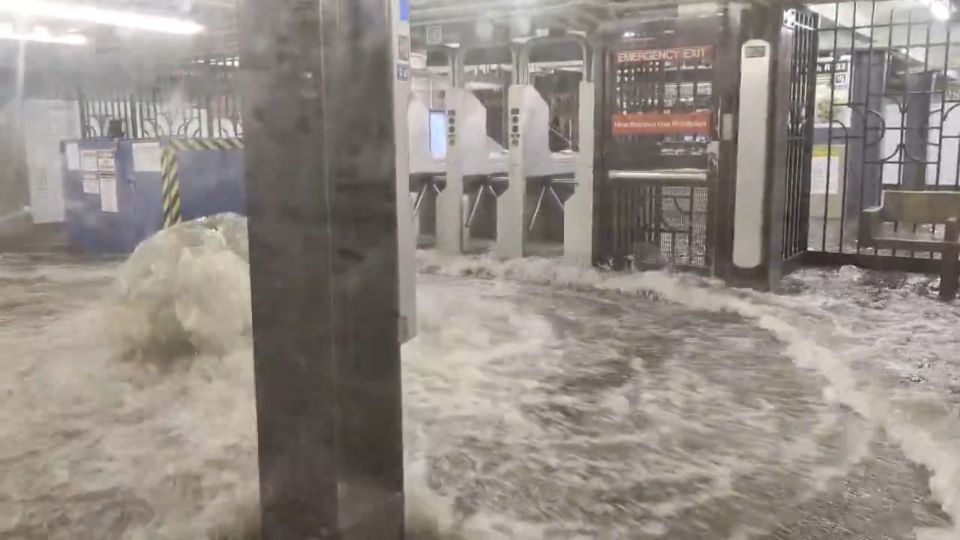Millions across the Northeast and Mid-Atlantic remain under flash flood watches early Tuesday as slow-moving summer storms brought heavy showers to the East Coast, impacting transportation and leaving people stranded in vehicles on waterlogged roads.
Flooding was reported near Newark, New Jersey, New York City, northern Virginia and southern Maryland, according to the National Weather Service, with more rain to come Tuesday.
A state of emergency was declared in New Jersey due to ongoing flooding, Gov. Phil Murphy announced Monday night, warning residents to “remain off the roads unless absolutely necessary.”
The weather service has warned that more rain is expected Tuesday after heavy showers swept east, including across New York City, which experienced its second wettest hour on record Monday night after a little over 2 inches fell between 7 p.m. and 8 p.m. local time. This record is only beat by the approximately three-and-a-half inches of rain recorded during the remnants of Hurricane Ida in 2021. New York City received a total of 2.64 inches of rain, shattering its previous record for July 14th rainfall set in 1908.
Videos on social media showed water gushing onto platforms in New York’s subway and flowing through subway cars as passengers crouched on seats. At least one subway station was flooded by the deluge, according to a spokesperson with the Metropolitan Transit Authority. Several trains were also suspended, delayed or rerouted due to the flooding, according to MTA’s website.
Metro-North Railroad and New Jersey Transit said on their X accounts that they were also experiencing delays due to flooding.
Several airports in the New York City area issued temporary ground stops and delays Monday evening, according to the Federal Aviation Administration. Impacts to air travel were also reported at Ronald Reagan Washington National Airport and Boston Logan International Airport.
In New Jersey and Pennsylvania, cars struggled to navigate flooded streets, according to videos on social media, with multiple people needing to be assisted, according to authorities.
North Plainfield, New Jersey, Mayor Lawrence La Ronde told CNN affiliate WABC that emergency crews rescued people from at least 30 homes, after streets became completely flooded and were impassable. About 30 people were sheltering overnight at a local community center, he said.
Flash flood warnings were extended well in to the evening hours Monday in New Jersey’s Essex and Union counties due the rain, according to the National Weather Service.
In Lancaster County, Pennsylvania, 16 water rescues were reported in Mount Joy Township Monday afternoon, according to the Mount Joy Fire Department.
“Starting around 2:00 p.m., intense rainfall dropped over 7 inches of rain in less than five hours, overwhelming stormwater infrastructure and inundating portions of the borough,” the fire department said in a Facebook post. “The west end of town was hardest hit, with reports of over 5 feet of water in some homes.”
A photo taken by the Franklin Fire Company showed firefighters conducting a water rescue after occupants became trapped in their vehicle in flood waters.
In Virginia, the National Weather Service issued a flash flood emergency late Monday for the cities of Petersburg and Colonial Heights, where upwards of 2-3 inches of rain fell in less than 2 hours.
Numerous water rescues were underway in Petersburg, it said in a post on X, as stream gauges surged to flood levels and intense rainfall rates continued.
As of early Tuesday morning, more than 200,000 people remained under a flash flood warning. Millions more, including those in the Washington, DC, Baltimore and Philadelphia metro areas, are under a flood watch.
Higher risk of flooding
Showers began developing Monday morning and dominated the Northeast by the latter half of the day as temperatures rose. The heaviest storms arrived by early evening, threatening rush hour commuters.
Much of the area inside the flood watch has seen up to 300% of their normal rainfall over the past two weeks. The recent rainfall, especially in parts of central New York and Pennsylvania over the weekend, has meant the soil is more saturated, raising the risk of severe flooding.
Places along the Berkshires in Massachusetts and Binghamton, New York, recorded as much as 4.5 inches of rain over 72 hours.
In a typical year, the weather service office in the DC-Baltimore area issues one or two moderate risk rainfall outlooks. This July alone, there have already been three: July 1, 9 and 14. In the past month, there have only been seven days when the DC-Baltimore area wasn’t under any excessive rainfall threat.
Record-breaking flood events have happened nearly back-to-back in recent weeks, most notably in Texas’ Hill Country, where more than 130 people died after catastrophic flooding on July 4. New Mexico, North Carolina and other East Coast states have also seen life-threatening floods and historic rainfall this month.
Overwhelming rainfall is becoming more prevalent in a warming world, as rising global temperatures drive weather toward extremes. Hourly rainfall rates have grown heavier in nearly 90% of large US cities since 1970, according to a recent study from the nonprofit research group Climate Central.
Storms thrive on warm, moist air, and with the nation approaching peak summer heat, this month has seen the perfect conditions for flooding rain. Heat-driven storms can drop torrential rain and tend to move more slowly and stagnate, as upper-level winds in the atmosphere weaken this time of year.
In urban areas, flood risk increases in part due to infrastructure. Many roads, sewers and drainage systems in the US were not designed to handle the kind of extreme rainfall events that are now becoming more common.
Concrete and pavement disrupt the natural absorption of water runoff, which keeps rain from soaking into the ground and instead sends it to storm drains that can easily overflow or become clogged with debris.
This story has been updated with additional information.
CNN’s Jillian Sykes, Taylor Romine, Sarah Dewberry and Briana Waxman contributed to this report.
For more CNN news and newsletters create an account at CNN.com
The post Flash flooding swamps Northeast metro areas as extreme rain threatens millions appeared first on CNN.



